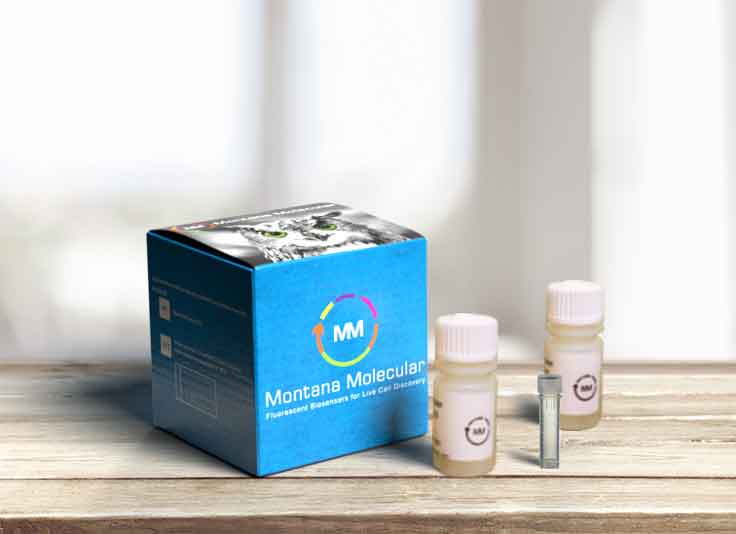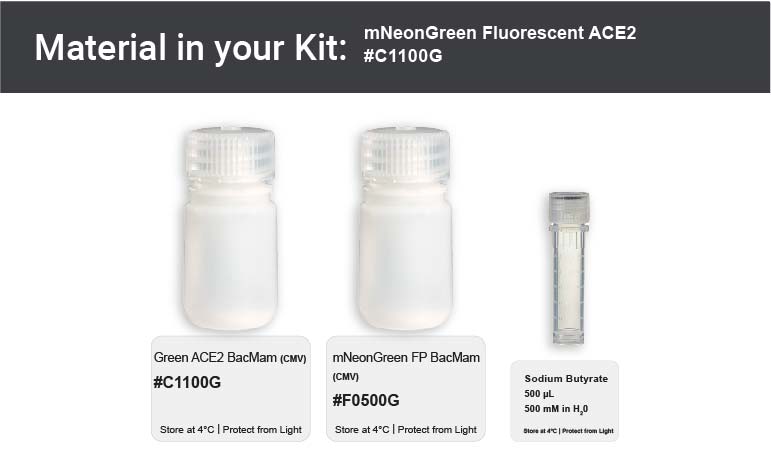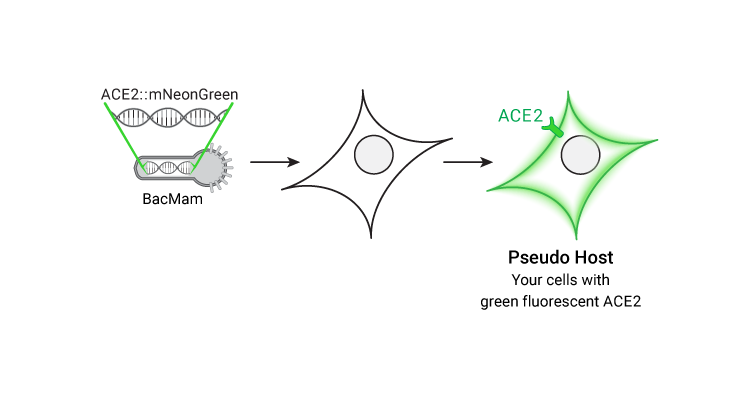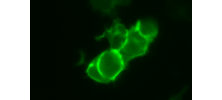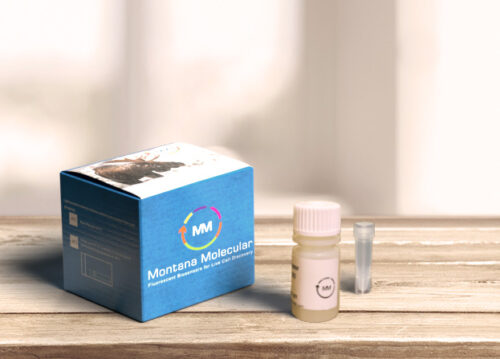ACE2 BacMam – Green Fluorescent (C1100G)
$595.00
Controlled expression of Green fluorescent ACE2 for SARS-CoV-2 drug screening.
Green Fluorescent ACE2
Express ACE2 labeled with a green fluorescent protein using a BacMam vector for controlled expression in a wide variety of cell types. Measure robust signals 24 hours post transduction on standard fluorescence plate readers and imaging systems. Turn any cell into a “pseudo host” cell.
Pseudo Host Cells
BacMam pseudovirus enters human airway cells and other primary cells that express the ACE2 and TMPRSS2 protein, but not all cells express these host proteins. To make HEK293 and other easily cultured cells into pseudo host cells, we offer red and green fluorescent ACE2 and TMPRSS2 in BacMam expression vectors. Transduce cells with BacMam expressing ACE2 and TMPRSS2, and the following day pseudo host cells are ready for the pseudo SARS-CoV-2 viral entry assay. If the pseudo virus enters the cells, it will produce bright fluorescence in the nucleus, a signal that can be blocked if viral entry is blocked. A significant advantage of creating pseudo host cells is that compounds can be screened using standard cell lines that are compatible with high throughput screening. Most laboratories can be screening for blocking agents within a few days, with a minimum of changes to their work flow or safety regulation requirements.
Materials in the Kit:
• mNeonGreen fluorescent labeled Angiotensin Converting Enzyme 2 (ACE2) in BacMam
• mNeon Green Fluorescent Protein BacMam
• Sodium Butyrate, 500 mM in H2O
• Detailed protocol
Additional information
| Protocol for Use | https://montanamolecular.com/covid-19-drug-discovery/fluorescent-ace2-protocol/ |
|---|---|
| Shipping | We strive for prompt delivery of each order, so we ship by FedEx 2-day service in lightweight, sturdy, and reusable/biodegradable packaging with an insulated cooler and moisture-resistant refrigerant gel packs. Shipping days are Mon-Wed so product does not sit in transit over the weekend. Web store ships to US & Canada only, contact sales for other locations. |
| MSDS | |
| Sequence Reference Number | NP_001358344.1 |
| Kit Volume | 5mL |
| More Info | https://montanamolecular.com/covid-19-reagents/host-factors-for-sars-cov-2-entry/ |
COVID-19 tools Publications
Pseudovirus and Host Factor Publications
- M.T. De Sibio, et al. Irisin Attenuates SARS-CoV-2 Entry Into Cells and Cell Damage in 2D and 3D Cultures of Human Subcutaneous Adipocytes. Endocrine Connections. July 2025.
- V. Fuochi, et al. Disrupting SARS-CoV-2 Spike–ACE2 Interactions via Glycosaminoglycans in a Pseudoviral Study of Heparan Sulfate and Enoxaparin. biomolecules. June 2025.
- V. Fuochi, et al. Antiviral efficacy of heparan sulfate and enoxaparin sodium against SARS-CoV-2. Arch Pharm. November 2024.
- I. Gkekas, et al. AI Promoted Virtual Screening, Structure-Based Hit Optimization, and Synthesis of Novel COVID-19 S-RBD Domain Inhibitors. Journal of Chemical Information and Modeling. November 2024.
- D. Thomas, et al. CCL2-mediated endothelial injury drives cardiac dysfunction in long COVID. Nature Cardiovascular Research. October 2024.
- L. Monteonofrio. Molecular mechanisms of thalidomide effectiveness on COVID-19 patients explained: ACE2 is a new ΔNp63α target gene. Journal of Molecular Medicine. September 2024.
- A. Atemin. Kinetic landscape of single virus-like particles highlights the efficacy of SARS-Cov-2 internalization. bioRxiv. June 2024.
- J. Elste, et al. Co-Expression of Niemann-Pick Type C1-Like1 (NPC1L1) with ACE2 Receptor Synergistically Enhances SARS-CoV-2 Entry and Fusion. biomedicines. April 2024.
- Z. Wang, et al. Inhalation of ACE2-expressing lung exosomes provides prophylactic protection against SARS-CoV-2. nature communications. March 2024.
- F. Chen, et al. Hypercapnia increases ACE2 expression and pseudo-SARS-CoV-2 entry in bronchial epithelial cells by augmenting cellular cholesterol. Frontiers in Immunology. October 2023.
- Y. Kyosei, et al. Removal of soluble ACE2 in VeroE6 cells by 17β-estradiol reduces SARS-CoV-2 infectivity. Biological and Pharmaceutical Bulletin. October 2023.
- V. Fuochi, et al. Antiviral Efficacy of Heparan Sulfate and Enoxaparin Sodium against SARS-CoV-2: An In-Vitro/in-Silico Model. Preprints. October 2023.
- S. Shahbaz, et al. Analysis of SARS-CoV-2 isolates, namely the Wuhan strain, Delta variant, and Omicron variant, identifies differential immune profiles. Microbiology Spectrum. September 2023.
- M. Farrag, et al. Structural requirements of Holothuria floridana fucosylated chondroitin sulfate oligosaccharides in anti-SARS-CoV-2 and anticoagulant activities. PLoS One. May 2023.
A. Maurya, et al. Structure, anti-SARS-CoV-2, and anticoagulant effects of two sulfated galactans from the red alga Botryocladia occidentalis. International Journal of Biological Macromolecules. March 2023. - X. Mei, et al. An inhaled bioadhesive hydrogel to shield non-human primates from SARS-CoV-2 infection. Nature Materials. February 2023.
- M. Spampinato, et al. Effects of Mangiferin on LPS-Induced Inflammation and SARS-CoV-2 Viral Adsorption in Human Lung Cells. Pharmaceutics. December 2022.
- S. Huang, et al. Long Chain N3-PUFA Decreases ACE2 Protein Levels and Prevents SARS-CoV-2 Cell Entry. International Journal of Molecular Sciences. November 2022.
- S. Shahbaz, et al. Differential effects of age, sex and dexamethasone therapy on ACE2/TMPRSS2 expression and susceptibility to SARS-CoV-2 infection. Frontiers in Immunology. November 2022.
- R. Dwivedi, et al. Anti-SARS-CoV-2 and anticoagulant properties of Pentacta Pygmaea fucosylated chondroitin sulfate depend on high molecular weight structures. Glycobiology. September 2022.
- A. Puhl, et al. Vandetanib Blocks the Cytokine Storm in SARS-CoV-2 Infected Mice. ACS Omega. August 2022.
- S.T. Chuang, P. Buchwald. Broad-Spectrum Small-Molecule Inhibitors of the SARS-CoV-2 Spike-ACE2 Protein-Protein Interaction from a Chemical Space of Privileged Protein Binders. Pharmaceuticals. August 2022.
- B.J. Travis, et al. Significance of chlorine-dioxide based oral rinses in preventing SARS-CoV-2 cell entry. Oral Diseases. July 2022.
- R. Dwivedi, et al. Inhibition of SARS-CoV-2 wild-type (Wuhan-Hu-1) and Delta (B.1.617.2) strains by marine sulfated glycans. Glycobiology. July 2022.
- Z. Wang, et al. Exosomes decorated with a recombinant SARS-CoV-2 receptor-binding domain as an inhalable COVID-19 vaccine. Nature Biomedical Engineering. July 2022.
- BR Jo, et al. A Novel Antiviral Protein Derived from Oenanthe javanica: Type I Interferon-Dependent Antiviral Signaling and Its Pharmacological Potential. biomolecules. June 2022.
- S. Chuang, et al. Methylene Blue Is a Non-Specific Protein-Protein Interaction Inhibitor with Potential for Repurposing as Antiviral for COVID-19. Pharmaceuticals. May 2022.
- L. Souza-Moreira, et al. Poly(I:C) Enhances Mesenchymal Stem Cell Control of Myeloid Cells from COVID-19 Patients. iScience. April 2022.
- A. Puhl, et al. Vandetanib Reduces Inflammatory Cytokines and Ameliorates COVID-19 in Infected Mice. bioRxiv. December 2021.
- R. Dwivedi, et al. Structural and kinetic analyses of holothurian sulfated glycans suggest potential treatment for SARS-CoV-2 infection. Journal of Biological Chemistry. September 2021.
- Q. Zhang, et al. ACE2 interaction with cytoplasmic PDZ protein enhances SARS-CoV-2 invasion. iScience. July 2021.
- D. Bojadzic, et al. Small-Molecule Inhibitors of the Coronavirus Spike: ACE2 Protein-Protein Interaction as Blockers of Viral Attachment and Entry for SARS-CoV-2. ACS Infectious Diseases. May 2021.
- A. Riad, et al. Differential gene expression by RNA-Seq in Sigma-2 Receptor/TMEM97 knockout cells reveals its role in complement activation and SARS-CoV-2 viral uptake. bioRxiv. March 2021.
- D. Bojadzic, et al. Methylene Blue Inhibits the SARS-CoV-2 Spike-ACE2 Protein-Protein Interaction-a Mechanism that can Contribute to its Antiviral Activity Against COVID-19. Frontiers in Pharmacology. January 2021.
- Pramanik, et al. The rapid diagnosis and effective inhibition of coronavirus using spike antibody attached gold nanoparticles. Nanoscale Advances. January 2021.
3CLglow Publications
- N. Deschenes, et al. Functional and Structural Characterization of Treatment-Emergent Nirmatrelvir Resistance Mutations at Low Frequencies in the Main Protease (Mpro) Reveals a Unique Evolutionary Route for SARS-CoV-2 to Gain Resistance. The Journal of Infectious Diseases. June 2025.
- J. Pérez-Vargas, et al. A novel class of broad-spectrum active-site-directed 3C-like protease inhibitors with nanomolar antiviral activity against highly immune-evasive SARS-CoV-2 Omicron subvariants. Emerging Microbes & Infections. August 2023.
- A. Citarella, et al. SARS-CoV-2 Mpro: A Potential Target for Peptidomimetics and Small-Molecule Inhibitors. biomolecules. September 2021.


